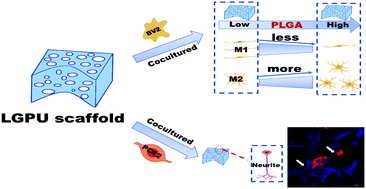A waterborne polyurethane 3D scaffold containing PLGA with a controllable degradation rate and an anti-inflammatory effect for potential applications in neural tissue repair†
Abstract
Currently, implanting tissue engineering scaffolds is one of the treatment methods for the regeneration of damaged tissues. The matching of the degradation rate of the scaffolds with the regeneration rate of the damaged zone is a big challenge in tissue engineering. Here, we have synthesized a series of biodegradable waterborne polyurethane emulsions and fabricated three-dimensional (3D) connected porous polyurethane scaffolds by freeze-drying. The degradation rate of the scaffolds was controlled by adjusting the relative ratio of poly-ε-caprolactone (PCL) and poly(lactic-co-glycolic acid) (PLGA) in the soft segment. The degradation rate of the scaffolds gradually accelerated with the increase of the relative proportion of PLGA. By co-culture with BV2 microglia, the scaffolds promoted the differentiation of BV2 into an anti-inflammatory M2 phenotype rather than a pro-inflammatory M1 phenotype as the proportion of PLGA increases. When the BV2 cells were stimulated with lipopolysaccharide (LPS), the scaffolds with a higher PLGA ratio showed a much stronger anti-inflammatory effect. Then, we demonstrated that the scaffolds could promote the PC12 neurons to differentiate into neurites. Therefore, we believe that the polyurethane scaffolds have a promising potential application in neural tissue repair.



 Please wait while we load your content...
Please wait while we load your content...